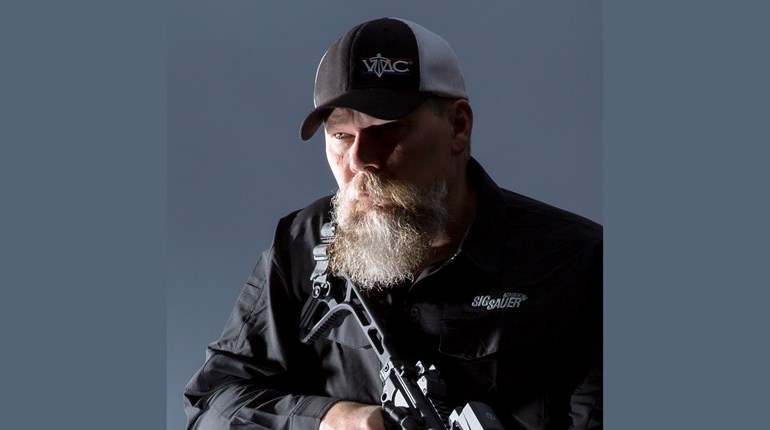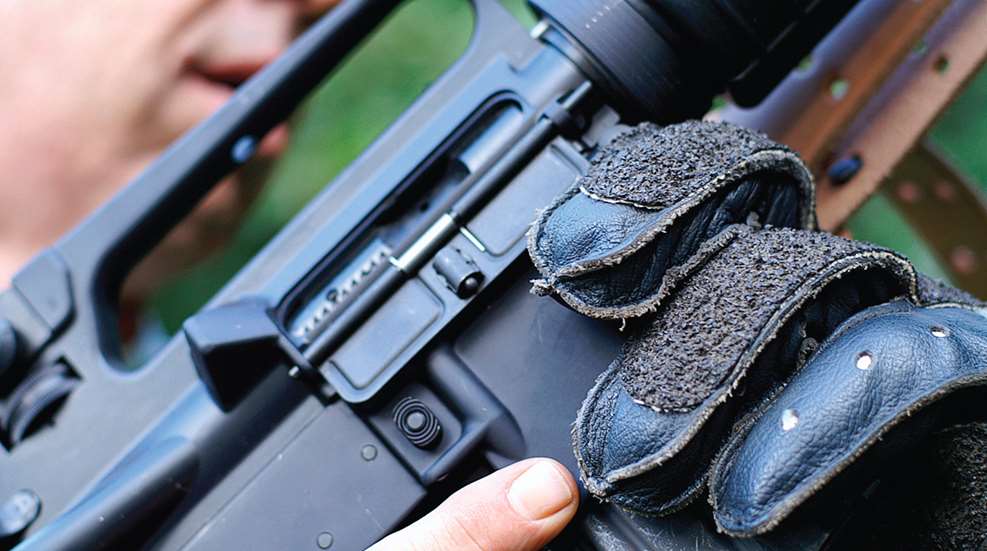
Given its popularity in NRA High Power Rifle competition, I’ll use the AR-15-platform for the majority of service rifle comparisons. A majority of High Power shooters start with a service rifle. I did. There are many who steadfastly believe that service rifle competition is the heart of NRA High Power Rifle and that’s hard to argue. There’s also an underlying sense that service rifle competition is akin to dues-paying—that no one can truly appreciate the sport unless they’ve had that experience. Of course, those wanting to participate in CMP events know that service rifle is the only vehicle that qualifies in attaining a Distinguished badge or President’s 100 tab. I know also that any local events I attend are heavily populated with service rifle owners. Match rifles stand out as something rare.
We’re talking about two tools put to the same purpose. Even a cursory glance at good examples of each rifle type points out significant differences. A match rifle sure looks like it would shoot better. “Sights” is the easiest answer why. That’s the most frequently given advantage, and target-style sights are, indeed, a big help to everyone. They may be the biggest help to those who encounter difficulty in getting a clear focus on the front sight element.
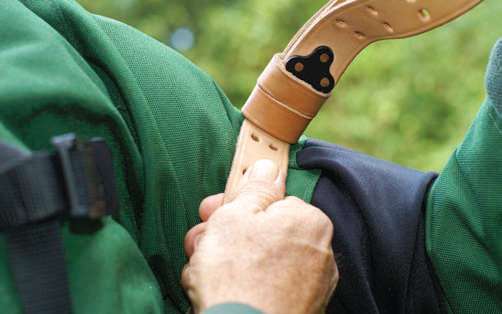
My universal preface throughout this article is “assuming you have invested in…” meaning, we’re pushing the rules and draining the wallet at the same time. Sure— even a disk-type rear aperture that is common on a target sight is an improvement over even a custom service legal rear aperture, but let’s not stop there. Let’s get a diopter-style (adjustable lens) rear insert with variable iris adjustment (aperture size) and thread that bad boy into a Warner or Centra sight. Throw in a few color filters and maybe a sunshade, learn how to run it, and suddenly the sight picture is fully tunable and therefore nicely visible for most anyone.
Go to the front sight and equip it with the same type and level of accessories—adjustable iris, sunshade, level and the “aiming” part of shooting becomes easy. (Note that lenses are available for the front sight but the rules don’t allow us to run lenses in both front and rear. Which approach works best for different people, is another topic.)
Sight-mounting options are likewise wisely exploited choices. Not everyone takes advantage of cant adjustment, mounting height, fore/aft rear sight location, or indexable front sight elevation, but it’s all easily done if, you the rifle to the shooter than it does sight picture, but that is, once again, an overriding advantage of a match rifle.
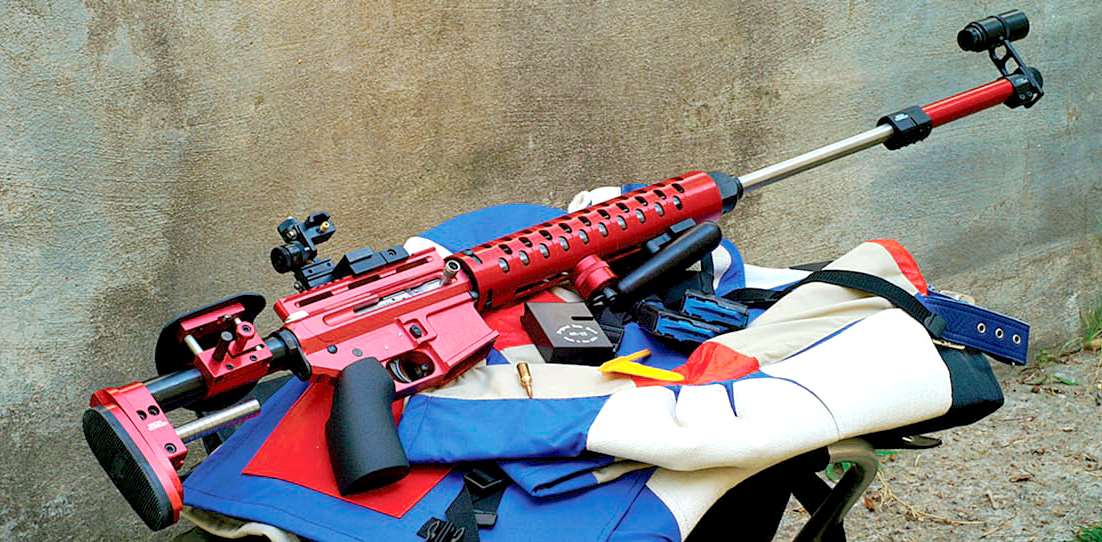
As suggested, there are, without any doubt, different “levels” of match rifles. Dig into it enough and there are no doubt varying efforts expended in outfitting a service rifle as well. If each rifle type is AR-15-based and using equivalent quality barrels and attention to construction, then there honestly is no difference in how well each will perforate a target. I’m talking about “clamped-in-a-vise” groups. However, fi red from the shoulder, there are differences. A match rifle usually shoots a better group for most people, especially at distance. A precision built bolt-action is capable of still better accuracy.
Beyond the sights, a big reason, then, that a match rifle helps most to a higher score is its accoutrements. For my money, figuratively and literally, it’s the furniture. The buttstock assembly and forend come first to mind. No one will truly get the full benefits the rules afford the match rifle owner unless that person decks the daggone thing out. Otherwise, it really does get back to better sights, pretty much. If, on the other hand, there’s an AR-15-based rifle with a tubular stock and enough Franklins thrown at employing creative tricks, that rifle can be molded, balanced, and bent to anyone’s preference and needs. It doesn’t have to be an AR-15, of course, because it could be a TUBB 2000 or one of the “tube-gun” Remington 700s that Gary Eliseo and others build.
This adjustability advantage of a match rifle is far from automatic because it takes experience and effort to exploit it all, but such a rifle can be well-fitted to the shooter’s position preferences. On the other hand, the shooter has to fit himself to a service rifle. The service rifle itself isn’t going anywhere but where it already is. An adjustable-stocked match rifle adds some complexity to preparation. With a service rifle it’s pretty much run the back sight and set the sling. With a match rifle, it’s run the back sight (and maybe the front sight), move the handstop, change the buttplate elevation, angle, length, and also cheekpiece height and cast. Maybe add or move a weight, and, of course, adjust the sling. Those, however, are all the advantages in the gun.
Switching to a match rifle will feel like cheating. However, you might be surprised that initially your scores may not be that much higher. If you are a 780/800 shooter with a service rifle, you probably won’t suddenly become a 790/800 shooter with a match rifle. On the other hand, if you’re in the 720/800 range with a smoke pole, you may shock yourself by seeing a 750/800 in short order after you trade up to a match rifle. I’ve found that the lower the score currently being fired with a service rifle the relatively higher score that shooter will see with a match rifle. Take a “first-time” beginner, given guidance, and it will be a radical difference. A match rifle will, not may, help a less-experienced shooter advance more quickly.
Essentially everything, point-by-point, is “better” on a match rifle. However, my own experience (which, always remember, is mine alone) has shown me that, while there’s no question that better is better and noticeable in every point-by-point, it was not as influential to my scores as I imagined. As suggested, I think honestly that the competitor still rising among the ranks will be the one who notices the most immediate and substantial benefit from the match rifle. I’ll do my best to explain that, but understandably have to restrict that to opinion.
I believe that after enough time, and we’re talking about a lot of time, that a service rifle becomes as much a part of a seasoned competitor’s position and approach to shooting as does an adjustable gun. I can go back and forth between match and service and don’t sense much, if any, transition, or at least not one that negatively influences performance. I’m that familiar with each. I do notice the sights, and notice that more and more the older I get. That’s just my own vision change that’s responsible.
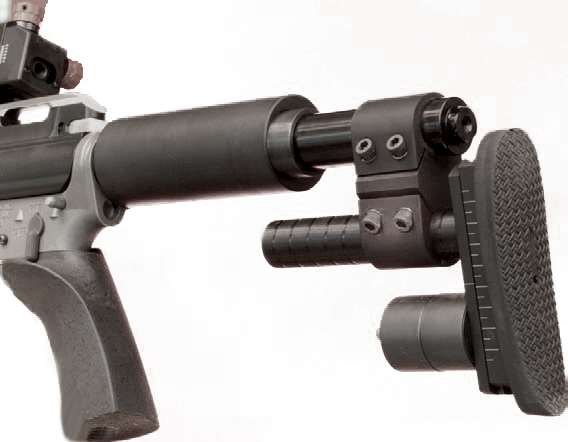
This short story in itself is a microcosm of the difference in these two rifle types. If he wants to shoot service rifle he will, and he’ll adapt and do well. If he doesn’t, he’s already that much closer to running up the scores he’s capable of firing. We made the match rifle fit him, and suit him, and so now he has to focus on event preparation and the mechanics of shooting those events. A match rifle makes shooting easier, and it makes learning to shoot easier.
Back to answering the original question: When is a High Power shooter ready for a match rifle? The only honest answer I have is just any old time. One will show you the scores you are capable of firing. Then, and only then, the shooter can fairly compare the guns.
Some More Points to Consider
X-counts are normally higher comparing match to service. Shots from each may all be “safe” 10’s but the match rifle helps direct those a tad more inward. That’s about points that don’t get away. It’s not always or certainly because the match rifle is more accurate, it just can be more precisely positioned on target, or that’s the effect. The longer barrel also means there will be a velocity advantage, no matter what, and that’s always good. This is even more skewed in the favor of the match rifle when it’s chambered in something stouter than .223 Remington.
One source for an edge in 600-yard, and to an extent 300-yard, targets comes from sights. It is easier to get a consistent sight picture, and the stock adjustment potential makes the match rifle more comfortable (and the position more consistent) in prone.
Certainly, the trigger on a match rifle can have a lighter pull weight, and that is better. The rules mandate no less than a 4-½-pound break on a service rifle. Since we’re talking, now, about a two-stage trigger in an AR-15 or M1A, it’s the combination of first- and second-stage resistance that satisfies that total. Not everyone likes them this way, but tuning a good trigger to its limit (at least in this direction) means that the service rifle shooter can be holding against, and therefore breaking, just about the same second-stage weight as a match rifle. If it’s an Anschütz in a TUBB 2000, we’re then at a whole different level of “good trigger.” Then there’s no comparison.
Standing position performance may or may not improve all that much, believe it or not. I can get my match rifle to sure seem a lot better for offhand, and that’s because of the tuning I can do to make it fit me. Funny, though, but my standing scores don’t change all that much. Again, I’m so used to shooting a service rifle, and actually like the post front sight for standing, that breaking on a center shot isn’t notably more difficult. I find a service rifle easier to shoot in a bad wind. It’s shorter. Sitting is about the same evaluation for me as standing. Yes, without a doubt the match rifle can be made to fit and feel better, but the scores are essentially the same. My back sight set up (which is built around prone) really doesn’t work as an ultimate, fit-wise, for sitting. I can’t or lean the rifle out in sitting and lean it in everywhere else.
Both these last two comparisons are, again, based a lot (maybe exclusively) on a shooter’s relationship in service rifle experience. As always and once again, the beginning to advancing shooter is going to think a match rifle is like cheating. The more experienced shooter, mostly, will find that a match rifle is just plain easier. It’s less work. I know I am physically more beat after going through an across-the-course with a smoke pole (AR-15).
Which Match Rifle?
Well, you all know me, and that means you’ll correctly predict a recommendation of a decked out AR-15-based gun. I’m not going to say that’s the best match rifle on the planet, but will say one will not be an excuse for not getting all the points anyone holds for. AR-15s are easy, fairly inexpensive (but that’s on a sliding scale), and certainly anyone making the transition from AR-15 service rifle to a match rifle built on the same chassis will adjust more quickly (not to mention reducing the outlay for magazines, maintenance gear, and so on). Change the cartridge if you’re willing to take on a little more effort at the loading bench. If your bank account is up to it, yes, a TUBB 2000 is probably the best. You’ll have to learn to work a bolt, but that’s not at all hard with that rifle. Otherwise, look into one of the “tube” guns most build around a Remington 700 action. “Conventional” match rifles, which are those built on bedded one-piece stocks, perform superbly on targets. There’s no doubt, though, that the newer breed of metal guns are easier to run. This is especially noticeable in rapid fire events.













